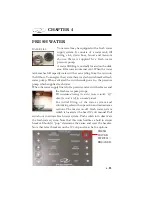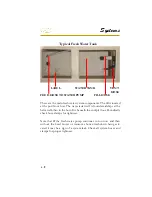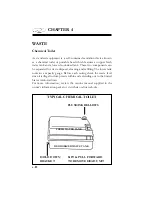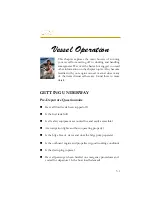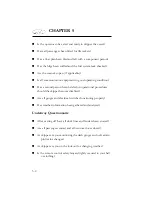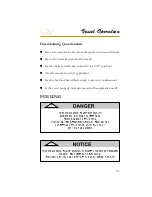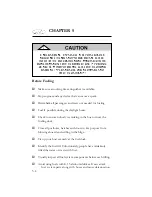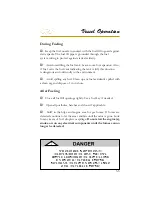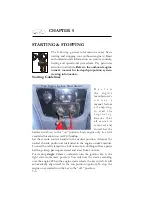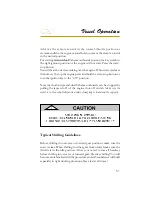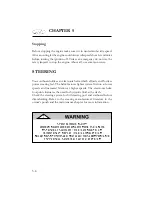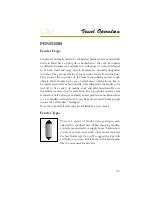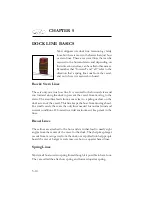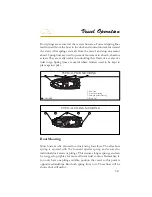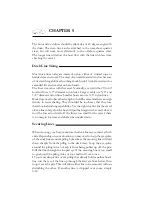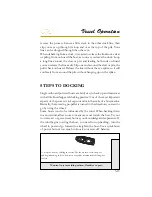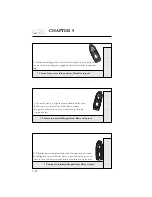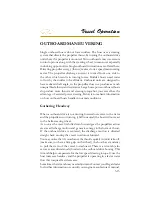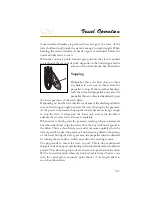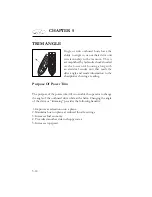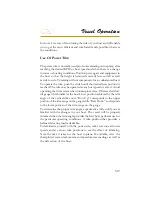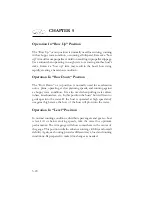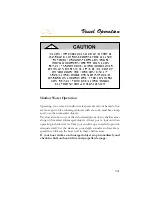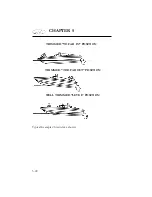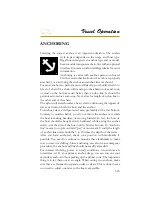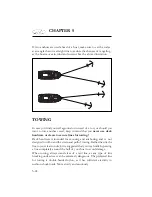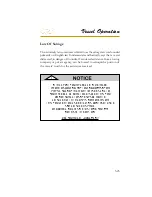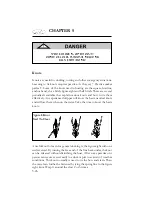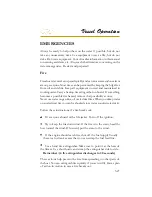
CHAPTER 5
5-12
The bow and stern lines should be relatively at a 45 degree angle with
the dock. The stern line can be attached to the near-shore quarter
cleat, but will work more effi ciently to the offshore quarter cleat.
The longer line will allow the boat fl ow with the tide with less time
checking the vessel.
Dock Line Sizing
Most dock lines today are made of nylon, either of twisted rope or
braided core and cover. The most often used material is nylon because
of its stretching abilities absorbing shock loads. It is chafe resistant for
extended life and is easier on bare hands.
The line’s size varies with the vessel. Normally, a vessel in the 20’ to 40’
boats will use 1/2” diameter nylon lines. Larger yachts use 5/8” and
3/4” diameter nylon lines. Smaller boats can use 3/8” nylon lines.
Dock lines need to have the strength to hold the vessel and have enough
density to resist chafi ng. They shouldn’t be too heavy that they lose
their shock-absorbing capabilities. Use the right size line for the vessel
since a line to large for the boat will pull hard against the vessel since it
won’t be forced to stretch. If the line is too small for the vessel, there
is no margin for wear and chafe when under strain.
Securing Lines
When mooring your boat, make sure the dock lines are secured at both
ends. Depending on your situation you may need to loop the eye splice
of the dock line around a piling. Sometimes the mooring line will lead
down sharply from the piling to the deck cleat. Loop the eye splice
around the piling twice to keep it from being pulled up off the pile.
Pull the line through the looped eye if the mooring line is too small
to go around the piling twice or too small to fi t over once.
If you must drop a line over a piling that already holds another boat’s
line, run the eye of the line up through the fi rst eye from below, then
loop it over the pile. This will allow either line to be removed without
disturbing the other. If another line is dropped over yours, simply
Содержание 29 OBX
Страница 1: ...OWNER S MANUAL OWNER S MANUAL 29 OBX 29 OBX REGAL 281760 REGAL 281760 3 2016...
Страница 2: ...THIS PAGE IS LEFT INTENTIONALLY BLANK...
Страница 7: ...INT 7 Introduction THIS PAGE IS LEFT INTENTIONALLY BLANK...
Страница 18: ...INT 18...
Страница 38: ...u v u w CHAPTER 1 NAVIGATION LIGHT RULES...
Страница 41: ...Safety On Board...
Страница 94: ...Engine Controls 3 27 Typical Switch Shown Above...
Страница 96: ...Engine Controls 3 29...
Страница 113: ...CHAPTER 4 TYPICAL EPA COMPLIANT FUEL TANK FILL HOSE VENT HOSE FEED HOSE ANTI SIPHON VALVE FUEL TANK LABEL...
Страница 162: ...Equipment Operation X Y Z Typical Dual Battery Switch Circuitry Front View...
Страница 163: ...CHAPTER 6 _ Dual Battery Switch Circuitry Rear View...
Страница 171: ...CHAPTER 6 CANVAS TRAVEL COVER...
Страница 182: ...Equipment Operation Depth Gauge With Functions...
Страница 196: ...Equipment Operation...
Страница 257: ...Cosmetic Care Maintenance 7 35 Notes...
Страница 262: ...Troubleshooting 8 5...
Страница 263: ...CHAPTER 8 8 6...
Страница 264: ...Troubleshooting 8 7...
Страница 265: ...CHAPTER 8 8 8 0 1 0 2 3 4 5 6 2 4 6 7 8 9 2 3...
Страница 273: ...CHAPTER 9 Notes...
Страница 294: ...Technical Information 12 3 TYPICAL LABELS LOCATIONS Power Tower...
Страница 299: ...Technical Information...
Страница 305: ...Technical Information Note Locate per Splash...
Страница 306: ...Technical Information...
Страница 310: ...Technical Information TYPICAL HULL HARNESS BREAKOUT...
Страница 311: ...Technical Information TYPICAL SWITCH PANEL BREAKOUT...
Страница 312: ...Technical Information TYPICAL DASH CHARTPLOTTER BREAKOUT...
Страница 313: ...Technical Information TYPICAL GARMIN YAMAHA NEMA 2000 NETWORK...
Страница 324: ...Technical Information...

